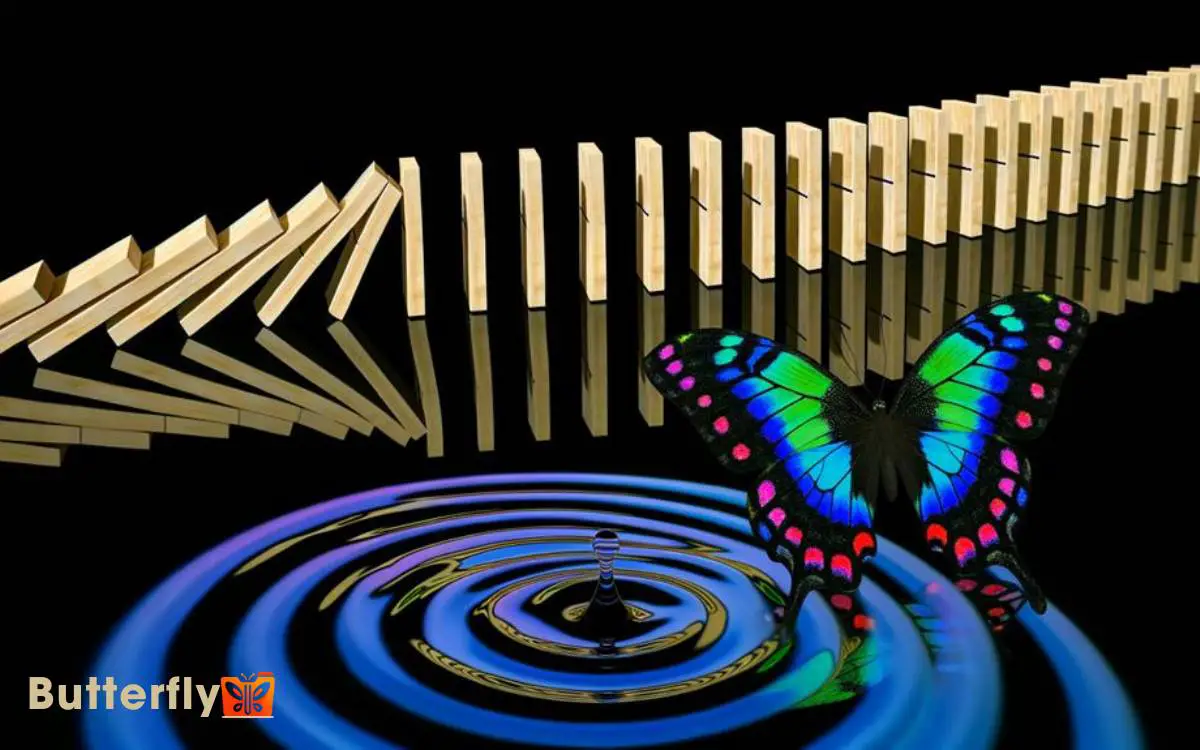Domino Effect Vs Butterfly Effect: Differences!
In contrast, the Butterfly Effect, from chaos theory, shows how small changes in initial conditions can lead to vastly different outcomes, often unpredictably.
While the Domino Effect is about direct, linear causation, the Butterfly Effect highlights exponential, indirect consequences.
Both concepts have significant implications, from historical events to psychological behavior. To truly grasp their impact and applications, there’s more to uncover.

Key Takeaways
Origins of the Domino Effect
The term ‘domino effect‘ originated from the visual and physical phenomenon where a small action causes a chain reaction of subsequent events, much like a line of falling dominoes. When you push one domino, it topples the next, creating a sequential cascade.
This concept is often used to describe how a single event can trigger a series of related occurrences. In systems theory, the domino effect helps you understand how interconnected components influence each other.
Recognizing this effect can aid in anticipating outcomes and managing risks in various fields, from engineering to social sciences.
Origins of the Butterfly Effect
You should understand that the Butterfly Effect originated from Edward Lorenz‘s work in chaos theory during the 1960s.
His research demonstrated how small changes in initial conditions could lead to vastly different outcomes in complex systems.
This concept fundamentally challenged the predictability in scientific models and introduced a new way of thinking about cause and effect.
Conceptual Foundation
In 1961, meteorologist Edward Lorenz inadvertently discovered the Butterfly Effect while working on weather prediction models. You’ll find it interesting that a minor change in initial conditions, like a tiny numerical difference, led to vastly different weather outcomes.
Lorenz’s insight came when he rounded off a number in his model, expecting minimal impact. However, the results diverged dramatically, revealing how small variations can escalate into significant consequences.
This concept challenged the traditional, deterministic view of predictability. It’s essential to understand that the Butterfly Effect doesn’t imply chaos but rather sensitivity to initial conditions.
By recognizing this, you can appreciate how interconnected systems behave unpredictably, even with slight alterations. Lorenz’s discovery laid the groundwork for modern dynamic systems analysis.
Chaos Theory Introduction
Emerging from the study of dynamic systems, Chaos Theory reveals how unpredictable behavior arises from deterministic processes.
You’ll find it fascinating that small changes in initial conditions can lead to vastly different outcomes, a concept known as the Butterfly Effect.
This theory was popularized by meteorologist Edward Lorenz when he discovered that tiny rounding errors in his weather models led to markedly different forecasts.
Here’s a quick overview:
| Concept | Definition | Example |
|---|---|---|
| Chaos Theory | Study of unpredictable behavior in deterministic systems | Weather patterns |
| Butterfly Effect | Small changes causing large variations in outcomes | Hurricane formation |
| Deterministic | Systems governed by fixed laws | Newtonian physics |
| Dynamic Systems | Systems evolving over time | Population growth |
| Initial Conditions | Starting state of a system | Early weather conditions |
Understanding these principles will deepen your grasp of complex systems.
Key Differences Explained
Understanding the key differences between the domino effect and the butterfly effect helps clarify how each concept operates within systems of cause and effect.
The domino effect describes a linear, predictable sequence where one event triggers the next, much like a row of falling dominos. Each event directly causes the subsequent one, making the pathway clear and straightforward.
In contrast, the butterfly effect highlights how small, seemingly insignificant changes can lead to vastly different outcomes in complex systems.
This concept emphasizes sensitivity to initial conditions, where minor variations can produce disproportionately large effects over time.
You can see that while the domino effect is more about predictability and direct causation, the butterfly effect deals with unpredictability and indirect, often exponential, consequences.
Historical Examples
To illustrate these concepts, consider the assassination of Archduke Ferdinand and patterns in hurricane formation.
You’ll see how the domino effect triggered a chain of events leading to World War I, while the butterfly effect explains how minor atmospheric changes can result in vast differences in hurricane paths.
Examining these examples clarifies the tangible impact of these phenomena on history and science.
Assassination of Archduke Ferdinand
The assassination of Archduke Ferdinand in 1914 is a prime example of how a single event can trigger a complex chain reaction, illustrating both the domino and butterfly effects in historical contexts.
When Gavrilo Princip shot the Archduke, it set off a series of events that led to World War I. You can see the domino effect as one nation after another declared war in a chain reaction.
| Event | Domino Effect | Butterfly Effect |
|---|---|---|
| Assassination | Immediate political tension | Long-term global conflict |
| Austria-Hungary’s ultimatum | Escalation of hostilities | New geopolitical alliances |
| Declaration of war | Widespread military mobilization | Changes in global power structures |
| World War I outbreak | Chain reaction of battles | Social and technological transformations |
This demonstrates how small actions can lead to significant, widespread consequences.
Hurricane Formation Patterns
Frequently, historical patterns in hurricane formation reveal the intricate interplay of atmospheric conditions and oceanic temperatures. You’ll notice that warmer ocean waters provide the energy needed for hurricanes to develop and intensify.
For instance, the infamous 2005 hurricane season, which included Hurricane Katrina, was fueled by exceptionally warm sea surface temperatures in the Atlantic. Additionally, atmospheric conditions, like low wind shear, allow these storms to grow unimpeded.
El Niño and La Niña events also greatly influence hurricane patterns. El Niño tends to suppress hurricane activity in the Atlantic but enhances it in the Pacific. Conversely, La Niña fosters more intense hurricanes in the Atlantic.
Scientific Foundations
Understanding the scientific foundations of the domino effect and the butterfly effect requires examining the principles of causality and nonlinear dynamics. You need to comprehend how small changes can lead to significant outcomes.
The domino effect illustrates linear causality where one event directly triggers a chain reaction. In contrast, the butterfly effect highlights nonlinear dynamics, where tiny initial conditions can drastically alter a system’s future state.
To explore further:
- Causality: Understand how actions and consequences are interconnected.
- Linear Systems: Investigate how predictable sequences unfold in a straightforward manner.
- Nonlinear Dynamics: Probe how small variables can lead to unpredictable, complex outcomes.
Real-World Applications
Real-world applications of the domino effect and butterfly effect reveal their profound influence across various fields, from economics to environmental science. For instance, in economics, a market crash triggered by a single event can create a domino effect, leading to widespread financial instability. Similarly, in environmental science, a small change in an ecosystem—such as the use of pesticides—can have butterfly effect-like consequences on biodiversity. This raises questions like does neem oil kill butterflies, highlighting the delicate balance between pest control and environmental preservation.
In economics, a single policy change can trigger a series of market reactions, exemplifying the domino effect. One altered interest rate can impact investments, consumer spending, and employment rates.
Conversely, the butterfly effect shows how minor environmental changes can escalate into significant weather patterns. For instance, slight deforestation can alter precipitation levels, affecting ecosystems miles away.
In public health, a small vaccination campaign can prevent widespread disease outbreaks, demonstrating the domino effect.
Understanding these concepts helps you anticipate and manage complex systems, ensuring informed decision-making. Both effects underscore the interconnectedness and sensitivity of systems to initial conditions.
In Popular Culture
Drawing from the intrigue of interconnected events, popular culture often explores the domino effect and butterfly effect to illustrate how small actions can lead to significant outcomes.
Films, novels, and TV series frequently incorporate these concepts to enhance their narratives.
- Movies: Films like The Butterfly Effect and Run Lola Run vividly depict how minor decisions can alter entire timelines.
- Literature: Books such as Ray Bradbury’s ‘A Sound of Thunder’ use the butterfly effect to show how a single action, like stepping on a butterfly, can change history.
- Television: TV series like Breaking Bad underscore the domino effect, where one choice cascades into a series of dramatic events.
These examples demonstrate how popular culture uses these effects to captivate and provoke thought.
Psychological Perspectives
Psychologists often examine the domino effect and butterfly effect to understand how seemingly trivial actions can trigger significant psychological and behavioral changes.
When you explore the domino effect, you see how one small action can lead to a chain of subsequent actions, impacting behavior and thought patterns.
Conversely, the butterfly effect highlights how minor variations in initial conditions can result in vastly different outcomes, emphasizing the unpredictability in psychological processes.
Both concepts help you grasp the complexity of human behavior.
By understanding these effects, you can better predict and analyze how small interventions might lead to meaningful changes in mental health, decision-making, and social interactions.
This insight is essential for developing effective therapeutic strategies and fostering positive behavior change.
Implications for the Future
Grasping the implications of the domino effect and butterfly effect can greatly enhance your ability to foresee and influence future developments in various fields. By understanding these concepts, you can better predict how small actions may lead to significant outcomes.
Consider these applications:
- Strategic Planning: Use the domino effect to predict and manage cascading consequences in business or policy.
- Innovation: Leverage the butterfly effect to foster creative solutions, where minor changes can spark major innovations.
- Risk Management: Anticipate potential risks by recognizing how small, seemingly insignificant factors might escalate into larger issues.
Conclusion
In the tapestry of cause and effect, you can see the dominoes falling in a precise line, each action leading to another, predictable and clear. Contrast this with the delicate flutter of a butterfly’s wings, where small changes birth vast, unpredictable outcomes.
Understanding both the domino and butterfly effects equips you to navigate life’s complexities, anticipate consequences, and embrace uncertainties. Your future, shaped by these phenomena, becomes a vivid landscape of interconnected possibilities.






